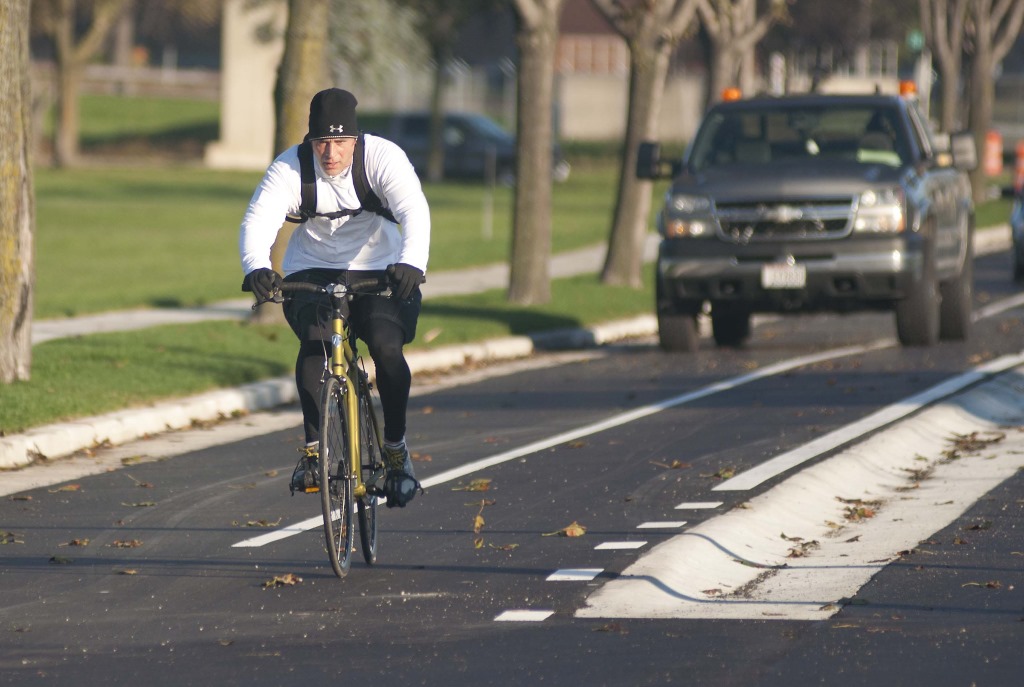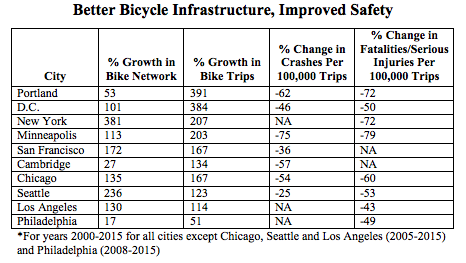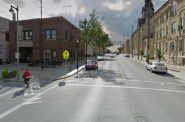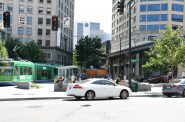Bicycling Getting Much Safer
Addition of protected bike lanes in cities reduces crashes, fatalities. Is Milwaukee next?

Bay View raised bike lane. Photo taken in 2011 while contractors (working out of the truck in the background) were still buttoning up a few punch list items on the project. Photo by Dave Schlabowske.
American cities still have a long way to go before they’re considered safe for people of all ages and abilities to bike. But many of them have made a lot of progress recently, especially the ones building protected bike lanes.

Cities building a lot of bike infrastructure are becoming significantly safer for cycling. Graph: American Public Health Association
That’s the takeaway of a recent data project featured in the American Journal of Public Health that examines crash and injury rates for cyclists in 10 American cities.
Researchers examined 10 cities that have been “especially successful at improving cycling safety and increasing cycling levels by greatly expanding their cycling infrastructure.” The above table shows recent changes in bike network growth, cycling rates, and crash and injury rates for cyclists in those cities. Minneapolis, Portland and New York City have seen the largest drop in injury and fatality rates among this group.
The change in bike trips in each city was determined using Census data about the number of bike commuters in a city. The authors assumed each bike commute accounted two trips per day and that these trips represented one-fifth of total bike trips. The assumption was based on the most recent National Household Travel Survey, which found that about one in five bike trips is work related.
Citing previous work by Kay Teschke, Anne Lusk, and other researchers, authors John Pucher and Ralph Buehler say it’s not just the volume of bike infrastructure that matters, it’s the quality as well.
While American cities have made improvements to cycling safety, they have a long way to go to be truly safe. Currently, the fatality rate for cyclists in the United States is almost five times as high as counties like Germany, Denmark, and the Netherlands, which have more robust bike infrastructure. U.S. cities need to continue to expand bike infrastructure, especially protected bike lanes, say Pucher and Buehler recommend, if they’re going to keep on reducing cycling deaths.
While Milwaukee has made many improvements to accommodate bikes, it has been slow to embrace protected bike lanes, and currently has only one, on Bay Street. However, as Urban Milwaukee has previously reported, a city program to resurface 60 miles of city streets will also create bike lanes on many of those roads. The 60 miles is a significant expansion of bike infrastructure, though protected lanes would have a significantly larger impact on safety.
Story by Angie Schmitt with additions by Urban Milwaukee. A version of this story originally ran on Streetsblog. Angie Schmitt is a newspaper reporter-turned planner/advocate who manages the Streetsblog Network from glamorous Cleveland, Ohio. She also writes about urban issues particular to the industrial Midwest at Rustwire.com.
Correction: The 60 miles of city streets will be getting bike lanes, not protected bike lanes.
Streetsblog
-
Car Culture Cements Suburban Politics
![Sprawl. Photo by David Shankbone (David Shankbone) [GFDL (http://www.gnu.org/copyleft/fdl.html) or CC-BY-SA-3.0 (http://creativecommons.org/licenses/by-sa/3.0/)], via Wikimedia Commons [ https://commons.wikimedia.org/wiki/File%3ASuburbia_by_David_Shankbone.jpg ]](https://urbanmilwaukee.com/wp-content/uploads/2017/10/1024px-Suburbia_by_David_Shankbone-185x122.jpg) Nov 23rd, 2018 by Angie Schmitt
Nov 23rd, 2018 by Angie Schmitt
-
Most Drivers Don’t Yield to Pedestrians
 Mar 22nd, 2018 by Angie Schmitt
Mar 22nd, 2018 by Angie Schmitt
-
Jobs Up Yet Driving Down in Seattle
 Feb 22nd, 2018 by Angie Schmitt
Feb 22nd, 2018 by Angie Schmitt
Transportation
-
MCTS Adds 28 New Buses
 Jul 13th, 2024 by Graham Kilmer
Jul 13th, 2024 by Graham Kilmer
-
MCTS Designing New Bus Shelters
 Jul 10th, 2024 by Graham Kilmer
Jul 10th, 2024 by Graham Kilmer
-
MCTS Updates RNC Bus Detours To Better Serve Downtown, Riders
 Jul 9th, 2024 by Jeramey Jannene
Jul 9th, 2024 by Jeramey Jannene






















Eh…While I’d love to believe that it is in the works or will happen, the referenced UM article did not confirm that the repacing prgram would be adding protected bike lanes…Bike lanes have been getting added around the city, but not protected ones.
Actual text: “Milwaukee currently only has one protected lane — on Bay Street. The quick-fix HIPP understandably doesn’t have funds for those higher level bicycle improvements, but now that the city has caught up with street repairs, it would make sense to begin budgeting to add protected bike lanes like our peer cities.”
The most concrete forward looking statement from the original article (http://urbanmilwaukee.com/2016/11/04/bike-czar-city-streets-makeover-adds-bike-lanes/) was that about a bicycle boulevard development on Fratney St.
@Rich You’re correct. I’ve made a correction
The next step would be to get the city to fill the potholes and crevasses in the street that throw people off their bikes
Driving east down newly paved and bike-laned Lloyd St., an anti-bicyle lane driver asked me why bike lanes aren’t placed on arterial streets where it would be much safer. It’s a good question. I pointed out those streets aren’t thoroughfares.
Claiming equality in the same traveling space for a bicycle and a steel framed and enclosed automobile at speed is silly, almost irresponsible. The news reels of full scale locomotives on the streets of early Chicago alongside horses and pedestrians was proven to be deadly and silly. (See: “Making of Chicago” series online or avail. through a library.)
Bus riders have a grandstand view of potential bike/vehicle collisions – for some reason Farwell Ave., North Ave. and Brady St. come to mind because of congestion.
There must’ve been a study about arterial streets and traffic stops being configured for more efficient bike lane placement. If not, isn’t this a rational approach for getting bikes off thoroughfares? For instance those streets parallel to North Ave., or Lloyd, or other stretches. Would there be less opposition / quicker implimentation of bike lanes.
Recent observations:
– I was glad to see a team of officers riding on the sidewalk this week on E. State Street. I do the same thing for safety purposes when sidewalks are clear.
– I’m a casual urban bike rider, and primarily a pedestrian who doesn’t appreciate being buzzed by a passing cyclist at speed as I step off a sidewalk. Even so, I’ve been cursed at when passing pedestrians on park pathways.
– Last month, pedestrians and the bus riders I sat with at N. Water and E. Wisconsin applauded the ticketing of a bike messenger by a cycle cop. The messenger raced through a westbound red light. It was quite an experience to see strangers coming together like that. Thank you bike messenger.
– Stopped cyclists in front of a column of traffic doing their little red light Samba or Virginia Reel in the crosswalk are a distraction and a traffic hazard.
@Gary
While riding on the sidewalk may seem safer, it is actually much more dangerous for you and others.
http://www.peopleforbikes.org/blog/entry/bike-myths-debunked
Additionally, people on bikes need to get to their destination just the same as people in cars, and often times arterial streets do not connect enough parts of the city, forcing bikers back on to thoroughfares without the appropriate infrastructure.
Many of your concerns, while justified, could be eliminated with the addition of protected bike lanes on city thoroughfares. Keeping bicyclists separated from traffic without having to go on the sidewalk, keeping bikes and cars in separate lanes of traffic to reduce the instances of “red light sambas”, lowering traffic speeds to keep roads safer for everyone, and lowering the barrier to entry for prospective urban cyclists.
Cheers!
Both @Gary and @MKE_BikeCommuter (back in the referenced article [http://urbanmilwaukee.com/2016/11/04/bike-czar-city-streets-makeover-adds-bike-lanes/]) have now brought up the POV that the city shouldn’t even be adding bike lanes to the major streets as they are. This strikes me as an awfully cynical and car-centric view… I’d love to see the numbers on injuries or deaths of cyclists who were properly using an established bike lane (and following other rules like red lights). We can all have our fears of the lunatic driver blasting down the bike lane space and killing someone from behind, but while said drivers probably exist, it’s likely extremely rare and thus should not be ranked so high in dictating transporation policy.
Cyclists want to use North Ave for all the same reasons a car does, because of where it goes. Moving the bikes to parallel Mienecke (for example) only lasts as good as that street crosses all barriers like freeways or railroad corridors and would actually cost more since each residential intersection would have to be reconfigured to establish some sort of right-of-way for cyclists, which by the way, would then only invite the same dreaded speeding cars to that road. Not to mention, the ultimate solution would call for eliminating a side of parking…While creative, I feel the least safe in those sport where “sharrows” have been used; in a fully painted and striped bike lane, far less so.
Plus adding bike lanes to an existing thoroughfare can usually be coupled with an overall traffic calming or road diet project. We kid ourselves that North Ave needs to be an ambiguous 50 ft wide with one center yellow stripe — it is exactly that lack of design that begets lunatics repurposing unmarked and empty pavement for another lane. Is the paint establishing the new bike lanes 100% perfect, no, but it clearly establishes who is supposed to be where and why. If usage — or god forbid, death rate — dictates, the bike lane space can be upgraded with additional protections during the next reconstruction
Call me socialist if you must, but using bike lanes to change road design and driver habits is not a bad thing. People whined and complained when S 2nd street was going to lose a travel lane in favor of bike space. No news since on how one cannot get around down there, the gas station at the center of the resistance is still in business and there have even been new apartments constructed near there.
Eh, comment editing would be nice…
“While creative, I feel the least safe in those **spots** where “sharrows” have been used; in a fully painted and striped bike lane, far **more** so.”
I retired in 2000, and am no longer bike commuting, but I was a year around commuter for 25 years.
My biggest problem with biking on the back streets is that there are way too many stop signs, sometimes inappropriately placed. I go through stop signs at about the same speed as cars but it is still slower than riding on an arterial. More cars will use those back streets if you remove the stop signs.
The street in the front of our house is more busy because people using it are trying to avoid stop lights. The recent hit and run killing of the 5 year old was on Leon Terrace, a street used to avoid traffic signals.
A couple of weeks ago I rode on Brady St. I have a trike these days, took the lane, and had no problems. I have a Bionx system on the trike so I could go 20 mph with e-power which helped a bit to keep drivers from being too frustrated.
I walk my small dog on the side walk in Milwaukee. She sometimes wanders from side to side. Frequently Cyclist power ride down the sidewalk ignoring the use of the bike lane on North Prospect. Riding on the sidewalk is illegal, it also places pedestrians, dogs on a leash in danger. I have never had a curious response from a cyclist when I have politely asked them to use the bike lane. Milwaukee is a dangerous city to live in because the Police do not enforce bike laws and traffic laws. We have frequently witnessed cars speeding through red traffic lights and stop signs, driving at excessive speeds, as well!
People and pet lives Matter, Milwaukee: A civil city it’s not!